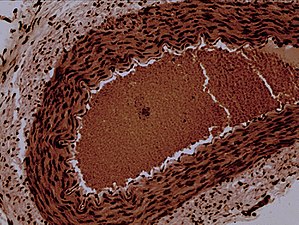| Arteriole | |
|---|---|
 Types of blood vessels, including an arteriole and artery, as well as capillaries. | |
 Rabbit arteriole at 100X | |
| Details | |
| Pronunciation | /ɑːrˈtɪəri.oʊl/ |
| Identifiers | |
| Latin | arteriola |
| MeSH | D001160 |
| TA98 | A12.0.00.005 |
| TA2 | 3900 |
| FMA | 63182 |
| Anatomical terminology | |
An arteriole is a small-diameter blood vessel in the microcirculation that extends and branches out from an artery and leads to capillaries.[1]
Arterioles have muscular walls (usually only one to two layers of smooth muscle cells) and are the primary site of vascular resistance. The greatest change in blood pressure and velocity of blood flow occurs at the transition of arterioles to capillaries. This function is extremely important because it prevents the thin, one-layer capillaries from exploding upon pressure. The arterioles achieve this decrease in pressure, as they are the site with the highest resistance (a large contributor to total peripheral resistance) which translates to a large decrease in the pressure.[2]
- ^ Maton, Anthea; Jean Hopkins; Charles William McLaughlin; Susan Johnson; Maryanna Quon Warner; David LaHart; Jill D. Wright (1993). Human Biology and Health. Englewood Cliffs, New Jersey: Prentice Hall. ISBN 0-13-981176-1.
- ^ Rahman, Masum; Abu Bakar, Siddik (4 December 2021). StatPearls [Internet] (Updated ed.). Treasure Island (FL): StatPearls Publishing. pp. 2–5. PMID 32310381. Retrieved 17 November 2022.